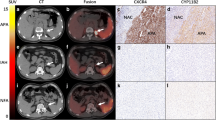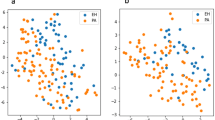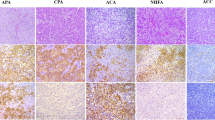Abstract
Objectives
We analyzed the diagnostic efficiency of 68Ga-pentixafor PET/CT for functional nodules in primary aldosteronism (PA). Furthermore, we compared the correlation of CXCR4 expression with aldosterone synthase (CYP11B2) expression and PET/CT uptake in these patients.
Methods
We prospectively assessed 50 patients diagnosed with PA and 10 patients with non-functional adrenal adenoma (NFA). All patients underwent 68Ga-pentixafor PET/CT before adrenalectomy. Immunohistochemistry (IHC) was performed to detect the protein expression of CYP11B2 and the G-protein-coupled receptor CXCR4.
Results
CYP11B2 IHC revealed the presence of 43 functional nodules. Subsequently, 40/43 functional nodules could be detected on 68Ga-pentixafor PET/CT, while negative imaging findings were noted for 11/13 non-functional nodules (sensitivity, 93.0%; specificity, 84.6%). The optimum SUVmax cut-off for the identification of functional nodules was 8.95 (AUC 0.914 [0.828–1.000], p < 0.001). Regarding the size of functional nodules, diagnostic efficiency appeared to be much higher for nodules greater than 1 cm in size (sensitivity, up to 97.3%). Moreover, we examined the relationship between CXCR4 and CYP11B2 expression in 56 lesions. All 43 CYP11B2-positive nodules were CXCR4-positive, but one of the 13 CYP11B2-negative nodules (7.7%) showed false-positive staining for CXCR4. Moreover, the consistency between PET/CT uptake and CXCR4 staining results was 92.9% (52/56).
Conclusions
At least 90% of functional nodules show positive uptake on 68Ga-pentixafor PET/CT, and the detection ability is much better for nodules with a diameter ≥ 1 cm. With its high sensitivity and specificity, 68Ga-pentixafor PET/CT can be considered a promising surgical decision-making tool for patients with PA.
Key Points
• 68Ga-pentixafor PET/CT could be a useful tool for the identification of functional adrenal nodules in APAs and even IHAs.
• The diagnostic efficiency appears to be much higher for nodules ≥ 1 cm in size.
• There is high consistency between the results of 68Ga-pentixafor PET/CT imaging and CXCR4 immunohistochemistry.



Similar content being viewed by others
Abbreviations
- APA:
-
Aldosterone-producing adenoma
- APM:
-
Aldosterone-producing micronodule
- ARR:
-
Aldosterone-to-renin ratio
- AVS:
-
Adrenal venous sampling
- CYP11B2:
-
Aldosterone synthase
- IHA:
-
Idiopathic hyperaldosteronism
- IHC:
-
Immunohistochemistry
- NFA:
-
Non-functional adrenal adenoma
- NPV:
-
Negative predictive value
- PA:
-
Primary aldosteronism
- PET/CT:
-
Positron emission tomography/computed tomography
- PPV:
-
Positive predictive value
- ROC:
-
Receiver-operating characteristic
- SUVmax :
-
The maximum standardized uptake values
- ZG:
-
Zona glomerulosa
References
Monticone S, Burrello J, Tizzani D et al (2017) Prevalence and clinical manifestations of primary aldosteronism encountered in primary care practice. J Am Coll Cardiol 69:1811–1820
Rossi GP, Bernini G, Caliumi C et al (2006) A prospective study of the prevalence of primary aldosteronism in 1,125 hypertensive patients. J Am Coll Cardiol 48:2293–2300
Williams TA, Gomez-Sanchez CE, Rainey WE et al (2021) International histopathology consensus for unilateral primary aldosteronism. J Clin Endocrinol Metab 106:42–54
Funder JW, Carey RM, Fardella C et al (2008) Case detection, diagnosis, and treatment of patients with primary aldosteronism: an endocrine society clinical practice guideline. J Clin Endocrinol Metab 93:3266–3281
Chatterjee S, Behnam Azad B, Nimmagadda S (2014) The intricate role of CXCR4 in cancer. Adv Cancer Res 124:31–82
Demmer O, Gourni E, Schumacher U, Kessler H, Wester HJ (2011) PET imaging of CXCR4 receptors in cancer by a new optimized ligand. ChemMedChem 6:1789–1791
Heinze B, Fuss CT, Mulatero P et al (2018) Targeting CXCR4 (CXC chemokine receptor type 4) for molecular imaging of aldosterone-producing adenoma. Hypertension 71:317–325
Ding J, Zhang Y, Wen J et al (2020) Imaging CXCR4 expression in patients with suspected primary hyperaldosteronism. Eur J Nucl Med Mol Imaging 47:2656–2665
Funder JW, Carey RM, Mantero F et al (2016) The management of primary aldosteronism: case detection, diagnosis, and treatment: an endocrine society clinical practice guideline. J Clin Endocrinol Metab 101:1889–1916
Ding J, Tong A, Zhang Y et al (2022) Functional characterization of adrenocortical masses in nononcological patients using [(68)Ga]-pentixafor. J Nucl Med 63:368–375
Williams TA, Lenders JWM, Mulatero P et al (2017) Outcomes after adrenalectomy for unilateral primary aldosteronism: an international consensus on outcome measures and analysis of remission rates in an international cohort. Lancet Diabetes Endocrinol 5:689–699
Acknowledgements
We are grateful to Dr. Celso E. Gomez-Sanchez (Department of Medicine, University of Mississippi Medical Center, Jackson, MS), who kindly provided antibodies against CYP11B2. Furthermore, we would like to thank all the reviewers who participated in the review and MJEditor (www.mjeditor.com) for linguistic assistance during the preparation of this manuscript. Anli Tong is deemed to take overall responsibility for all aspects of the study (ethics, consent, data handling and storage, and all other aspects of Good Research Practice). This research was funded by the National Natural Science Foundation of China (Grant Nos. 81770427 and 82070822). The study received ethical approval from the ethics committee of Peking Union Medical College Hospital (IRB protocol #ZS-1435).
Funding
This study has received funding by the National Natural Science Foundation of China (Grant Nos. 81770427 and 82070822).
Author information
Authors and Affiliations
Corresponding authors
Ethics declarations
Guarantor
The scientific guarantor of this publication is Anli Tong.
Conflict of interest
The authors declare no competing interests.
Statistics and biometry
No complex statistical methods were necessary for this paper.
Informed consent
Written informed consent was obtained from all subjects (patients) in this study.
Ethical approval
Institutional Review Board approval was obtained (IRB protocol #ZS-1435).
Methodology
• retrospective
• diagnostic or prognostic study
• performed at one institution
Additional information
Publisher’s note
Springer Nature remains neutral with regard to jurisdictional claims in published maps and institutional affiliations.
Yinjie Gao and Jie Ding are co-first authors.
Supplementary information
Table S1.
Clinical characteristic of enrolled patients *ARR ([ng/dl]/[ng/ml/h]) = Plasma aldosterone concentration (ng/dl) / Renin activity (ng/ml/h). When the renin activity was lower than 0.2 ng/ml/h, the ARR was calculated using 0.2 as the denominator. Quantitative variables with normal distribution are expressed as means ± standard deviations, and other quantitative variables are expressed as median (quartile). *Four APA patients with bilateral lesions underwent unilateral operation eventually according to the results of 68Ga-pentixafor PET/CT, of which the lesions with positive imaging were removed. (PDF 33 kb)
Rights and permissions
Springer Nature or its licensor holds exclusive rights to this article under a publishing agreement with the author(s) or other rightsholder(s); author self-archiving of the accepted manuscript version of this article is solely governed by the terms of such publishing agreement and applicable law.
About this article
Cite this article
Gao, Y., Ding, J., Cui, Y. et al. Functional nodules in primary aldosteronism: identification of CXCR4 expression with 68Ga-pentixafor PET/CT. Eur Radiol 33, 996–1003 (2023). https://doi.org/10.1007/s00330-022-09058-x
Received:
Revised:
Accepted:
Published:
Issue Date:
DOI: https://doi.org/10.1007/s00330-022-09058-x




